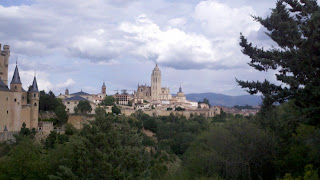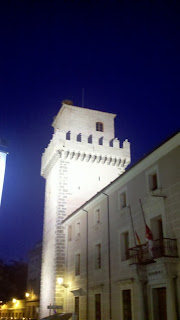Geographically speaking, Segovia is situated in a fantastic locations for many different activities and the one we chose last week was a visit to several different castles. We began the day by visiting a monastery at Santa María La Real de Nieva where we were shown how religious scenes were carved at the top of different posts to teach the local people of whom the majority were illiterate. We continued on to a winery where we were shown the entire process of wine making from the growing of the grapes to the bottling and we were then allowed to sample several wines. Continuing on we made our way to the Castle of Coca which is a perfectly restored castle we were allowed to tour. Lunch followed in a town called Turegano at El Zaguán where we dined on sopa casteallana (castillian soup), judiones de La Granja (Great White Northern Beans with local sausage) and finally cordero (lamb). Bellies full some people walked up to the local castle and then we boarded the bus to head to Pedraza - an entirely walled in city. A fantastic day!
Here are more photos from each visit:
Santa María
Viñedos Nieva
Castillo de Coca
Turegano
This blog chronicles the happenings of the NC State Study Abroad Program in Segovia, Spain in 2011. Please follow our travels!
martes, 31 de mayo de 2011
"Chocolate, chocolate"
Most of you have not been to Segovia. It makes San Francisco look like Kansas with the amount of hills we are climbing on a daily basis. And STEPS! WHY ARE THERE SO MANY STEPS EVERYWHERE?!! The point I am making is that we burn a fair amount of calories. So what better way to get back that energy than by drinking a 10 ounce cup of rich, thick, hot melted chocolate followed by wonderfully deep fried churros? Yep. I felt my heart slow down when I finished the cup.
https://picasaweb.google.com/jamesmcconnell1996/Segovia2011WalkingTourAndChocolateAtValor?authkey=Gv1sRgCJDArveI_6LSggE#
https://picasaweb.google.com/jamesmcconnell1996/Segovia2011WalkingTourAndChocolateAtValor?authkey=Gv1sRgCJDArveI_6LSggE#
Museo Esteban Vicente
The Esteban Vicente Museum has a very cool exhibit right now and our students were able to participate in an interactive exhibit. It is titled "The Dama de Corinto" and it reflects the myth of painting and the foundational myth of cinema. It was also free and they recorded the students. Pretty awesome.

Here are four lnks:
1. Museum info 2. More info, 3. Spanish information on the myth, 4. A short video
Most importantly our photos are here: https://picasaweb.google.com/jamesmcconnell1996/Segovia2011MuseoContemporaneoDeEstebanVicente?authkey=Gv1sRgCIqii4_ahNOONA&feat=email#
The first few days
Work, work, work! That is what the first few days are like regarding classwork so people can get in a routine for the academics. However, we do get out and see / do a lot the first week.
To see more fotos from the first few days please go here: https://picasaweb.google.com/jamesmcconnell1996/Segovia2011TheFirstFewDays?authkey=Gv1sRgCL7Yqqypm9mwaQ#
A walking tour of the area takes us by the Alcazar
Streets are filled with pelusas which is the name for the local pollen
The Alcazar as seen from below
The park below the Alcazar is great for Frisbee!
The cathedral from afar
Cathedral from another perspective
Crosses that are as old as our country!
Group near the Alcazar
Arrival in Spain!
"They're here!" That is what goes through my head every year as I cross the street and head into the Barajas Airport in Madrid, Spain. This year our group is smaller than normal with 10 students but there are far more positives than negatives with fewer students. So what does the first day look like for them? LONG! Since Spain is 6 hours ahead of the US the flights typically leave at night so you arrive in the morning and, much like myself, many of the students were not able to sleep on the plane. A typical travel day looks like this: wake up at 8 or 9 Raleigh time, catch an early afternoon flight to another airport, fly 8 hours to Madrid, take a 70 minute bus ride to Segovia and then, "Surprise!" Your new family is there when you get off the bus so they can whisk you away to a home you have never seen before, feed you and put you to bed around 2:30 or 3:00. If you don't sleep on the plane you are typically awake for 24 hours straight! Luckily they are very resilient. What are some of the things we were seeing the first few days? Well here you go!
African Puppets from the Titirimundi Festival
Tia Maria / Merry Go Round from France
Church at night
Cathedral at night
Aqueduct
Gift from Rome
Suscribirse a:
Comentarios (Atom)

























